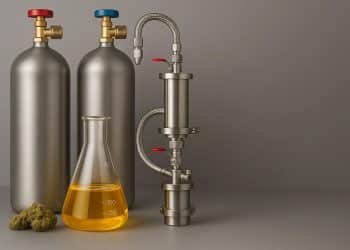The open-loop and closed-loop systems can be applied to methods of extracting phytocomplexes from plant matrices. It is possible to choose which of the configuration to use in order to obtain the maximum extraction yield while earning the most faithful extract composition and avoiding the risk for the operator and the environment.
Open-Loop Systems
An open-loop strategy is adopted in which multiple flows of input and outputs are possible, but usually, they follow either one of the following systems, including cradle to grave, cradle to gate, and gate to gate system, respectively. An example of such a close loop strategy was presented for the lignin recovery during pulp and bio-ethanol processes, followed by lignin utilization as an energy source. [1]
Open-loop extraction involves the collection of active ingredients from a plant matrix using an open-ended tube. It is possible to use lipophilic organic (n-hexane, n-pentane) or hydrophilic (ethanol) solvents.
The most commonly encountered problems:
- Solvent residues in the concentrates
- Drying extracts or the separation of the solvent may lead to decomposition of the target compounds or even the production of artifact molecules
- Exposition to flammable solvents of the operator
Closed-loop Systems
A close loop occurs when all the inputs and outputs are in the cycle, one of the products can be the raw material of other processes. The repeated washing extracts as many compounds as possible. The ISO 14044 standard defines a closed-loop strategy as the process of recycling a material without affecting its inherent properties in any way. [1]
The setting consists of:
- Solvent reservoir;
- Trim tube;
- Evaporation chamber;
- Consecutively vacuum pump, recovery pump and vacuum oven;
- Gas detector.
This system provides a more stable and environmentally friendly platform for dealing with volatile extract. [2]
Supercritical fluids such as CO2, are the greenest and generally the most used in closed-loop protocols thanks to the possibility of reusing them several times or even being recovered for other processes. Risks are minimal, but this kind of systems are more expensive than others. The yield performance is significantly superior to open-loop and purer concentrates as the separation of the solvent from the extract is much simpler.
With hydrocarbon solvents the risk can be much bigger because these gasses are pressured and highly flammable. In a closed loop system, there is no possibility of solvent releases or leaks if the equipment is used safely, and maintenance is carried out according to risk control standards.
Essential Oils Industry
The industry of essential oils has always used open loop extraction methods like classical distillation in field from fresh raw material. During the 70’s the close loop systems took place in order to gain yield. The FDA started considering butane and propane as GRAF (Generally Recognized As Safe) usable and permitted solvents in the production of food. [3]
Residues, in small concentrations, are tolerable and the risk is minimal even with continuous exposure. Essential oils are commonly used for external treatment, but in many cases flavorings and other odorous products for culinary use have a strong derivation from the plant extractive industry.
Applications in Cannabinoid Extraction
Open-loop and closed-loop systems with butane hash oil (BHO) have been applied to extract terpenes with more flavors and aroma from Cannabis. However, the closed-loop system is often used, as it is much safer and with more advantages than the open-loop setting.
BHO is one of the cheapest and efficient solvents that offer the most desired final product. However, its most common disadvantage is being hard to handle in bigger batches, as it is highly flammable, colorless, and odorless. Therefore, the legal use of BHO is restricted to licensed producers. [2]
Some scholars in 2018 presented data for cannabinoid and terpene content of six cannabis chemovar inflorescences and of extracts generated from their trim. Extracts were produced by extracting with supercritical CO2 in a closed-loop system for 6 h.
The temperatures of the extractor, separator and condenser were set correctly and operated at the right pressure. After separating the CO2 in the separator, the concentrated extract was treated in a vacuum oven for 24 h at a reduced pressure and at 49°C for the removal of residual water.
Additionally, the authors presented for each reported component the ratios between its concentration in the extract, on the one hand, and in the flowers, on the other. The conclusion reached was that the extraction protocol enhances the potency of both cannabinoids and terpenoids, but in a different fashion. [4]
References:
- Aqib Hassan Ali Khan, Amna Kiyani, Mario Santiago-Herrera, Jesús Ibáñez, Sohail Yousaf, Mazhar Iqbal, Sonia Martel-Martín, Rocío Barros. Sustainability of phytoremediation: Post-harvest stratagems and economic opportunities for the produced metals contaminated biomass. Journal of Environmental Management. 2023.
- Al Ubeed HMS, Bhuyan DJ, Alsherbiny MA, Basu A, Vuong QV. A Comprehensive Review on the Techniques for Extraction of Bioactive Compounds from Medicinal Cannabis. Molecules. Jan 2022.
- https://www.accessdata.fda.gov/scripts/cdrh/cfdocs/cfcfr/CFRSearch.cfm?fr=173.350
- Sexton M, Shelton K, Haley P, et al. Evaluation of cannabinoid and terpenoid content: cannabis flower compared to supercritical CO2 concentrate. Planta Med. 2018.












